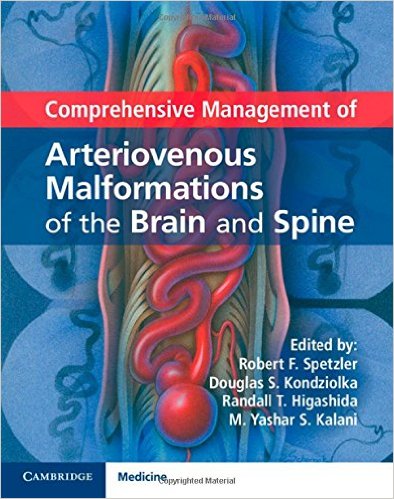Editors: Robert F. Spetzler, MD; Douglas S. Kondziolka, MD; Randall T. Higashida, MD; and M. Yashar S. Kalani, MD
Publisher: Cambridge University Press – 336 pages
Book Review by: Nano Khilnani
Malformations in the human vascular system are relatively rare, but for those who have them and for their families, they can cause mild to severe physical pain or pressure, psychological stress, and economic burdens, the editors and authors of this book point out.
The anomalies impinging upon parts of the brain or spine can take several forms. They could be fistulae, lesions or tumors, or other masses.
In the past, many neurosurgeons were reluctant to tackle them, but with advancements in microsurgery, management of patients with these problems became possible. And recent developments in interventional neuroradiology and radiation oncology have resulted in more treatment options for patients with arteriovenous malformations (AVMs).
The very reason for the development and publication of this text is to introduce those solutions to researchers and practitioners. This book summarizes the state of the art in this relatively new field. The editors point out that it is important to use the decision-making process correctly in selecting patients, and further, to carefully use single or multi-modality treatment solutions for those individuals.
Eighty-five people, mainly from the United States, but also from Canada, Finland, Germany, Italy, and the United Kingdom, wrote the 28 chapters that constitute this unique text on malformations in blood vessels (arteries, veins, capillaries) that form part of the human brain and spine network.
They are connected with departments of medical institutions – hospitals and universities – that study and treat malformed vessels and related conditions. Their areas of specialization are: anesthesiology, critical care medicine, endoscopy, imaging, neurology, oncology, perioperative care, radiology, rehabilitation medicine, surgery, and combinations of these disciplines, or subspecializations within them.
The entire contents of this book with its 28 chapters are divided into four main Sections, namely:
- Section 1 – Development, Anatomy, and Physiology of Arteriovenous Malformations of the Central Nervous System: 5 chapters
- Section 2 – Evaluation and Treatment Considerations for Arteriovenous Malformations: 5 chapters
- Section 3 – Surgical Approaches to the Treatment of Arteriovenous Malformations: 5 chapters
- Section 4 – Medical, Endovascular, and Radiosurgical Treatment of Arteriovenous Malformations: 13 chapters
Sixteen (16) videos on various procedures are also available to readers of this book. Go to this web address to find out how you may view them (we could not find a link in the text of this book):
http://www.cambridge.org/us/academic/subjects/medicine/neurology-and-clinical-neuroscience/comprehensive-management-arteriovenous-malformations-brain-and-spine?format=HB
This volume is essentially on updated findings on the molecular biology, development, natural history, treatment, and outcomes of patients with lesions in their neurovascular system.
The editors caution the physician readers that no treatment should be offered or executed unless you fully understand “the risks of morbidity and mortality associated with the natural history of the lesion and how the risk compares with the risks associated with various treatment modalities, or with observation alone.”
Each chapter begins with a concise Introduction, then presents discussions of the main topics and subtopics relating to the chapter title, alongside charts, drawings in fine lines, micrographs, tables, and other visual aids. A brief paragraph with Conclusions is provided towards the end of the chapter, and typically, large lists of References end it.
This is an excellent and quite comprehensive resource on AVMs.
Editors:
Robert F. Spetzler, MD is JN Harber Chairman of Neurological Surgery, and Director of Barrow Neurological Institute in Phoenix, Arizona.
Douglas S. Kondziolka, MD, MSc, FRCSC, FACS is Professor of Neurosurgery, Vice Chair of Clinical Reserarch (Neurosurgery), Professor of Radiation Oncology, and Director of the Center for Advanced Neurosurgery at New York University Langone Medical Center in New York, NY.
Randall T. Higashida, MD is Clinical Professor of Radiology, Neurological Surgery, Neurology, and Anesthesiology, and Chief of the Division of Interventional Neurovascular Radiology at the University of California San Francisco Medical Center in San Francisco, California.
Yashar S. Kalani, MD, PhD is Assistant Professor of Neurological Surgery at Barrow Neurological Institute in Phoenix, Arizona.







